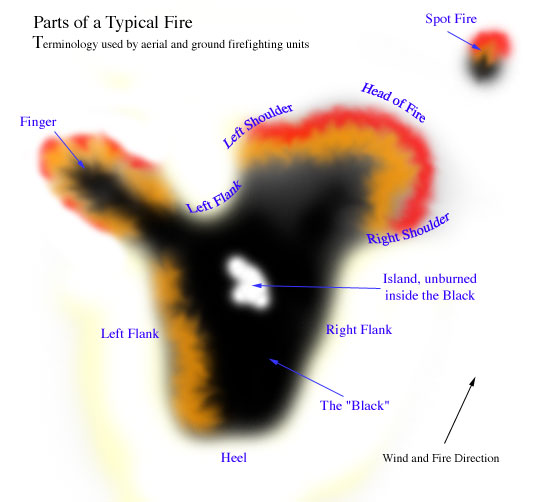Wildland firefighters use very specific terminology to describe the various parts of a fire. The fastest-moving portion is designated the “head” of the fire, the sides of the fire are known as the “flanks”, and the slowest moving portion is known as the “tail” or “heel” of the fire. The origin of the fire is usually near the heel. A “finger” is a small area that is protruding from the main body of the fire, and may previously have been the head before a wind shift caused the fire to spread in a different direction.
Depending on the fuel and its arrangement, the head typically has the greatest flame length, flame depth, and rate of spread. This is also where the most active attack on the fire takes place.
The flanks of a fire burn outwards into the unburned vegetation. This results in the flanks having less alignment with the wind than the head, normally reducing their intensity and rate of spread. Flank fire intensity nearest the head is higher, particularly where the flanks meet the head which is known as the shoulder.
The rear portion of a fire is called the tail or heel, and is where there is the least amount of fire spread. Usually the flames at the tail are being bent towards the already-burnt fuel. The tail or heel is potentially the slowest moving part of a fire with the shortest flame length. Tail fires usually demonstrate low amounts of fire activity, but present a significant risk if they burn into areas that are more supportive of increasing fire behavior.
An “island” is a portion of unburned fuel that is inside the “black” (burned area) of an active fire. This often occurs when there are high moisture levels in that area, or when the type of fuels or the topography of that area do not lend themselves to burning.
“Spotting” occurs when the burning embers of fuel are carried upwards by wind and then distributed amongst the areas of unburnt fuel ahead of the main fire. The area immediately under the smoke plume is particularly vulnerable to spotting, although embers can be carried considerable distances and result in significant secondary fires. Spotting can break control lines or threaten the escape routes of ground personnel working the fire.

Parts of a fire. Image courtesy of Becoming an Air Tanker Pilot.
![]()




One Comment